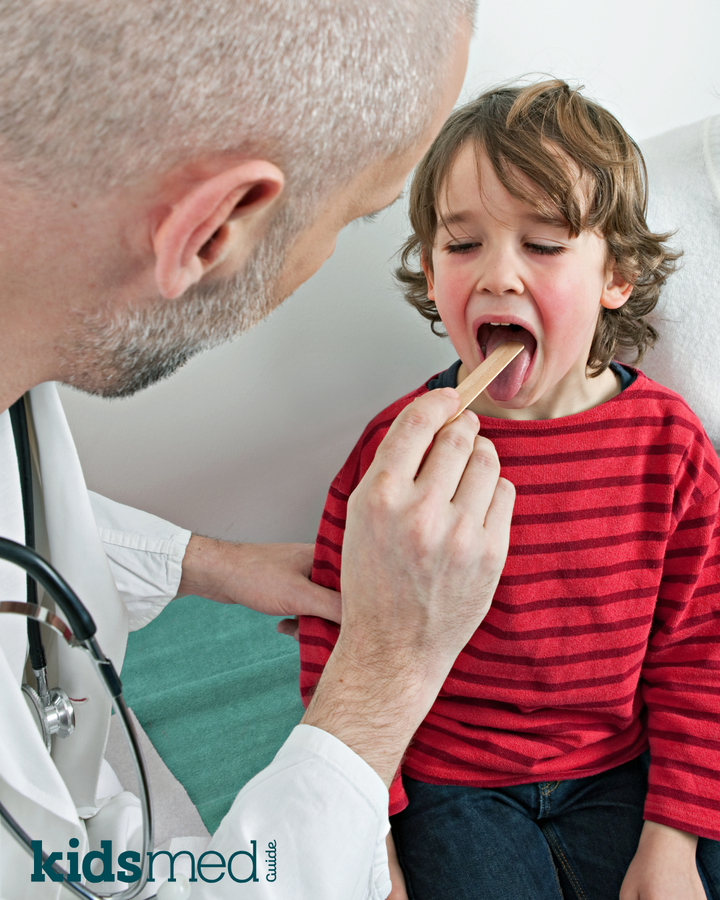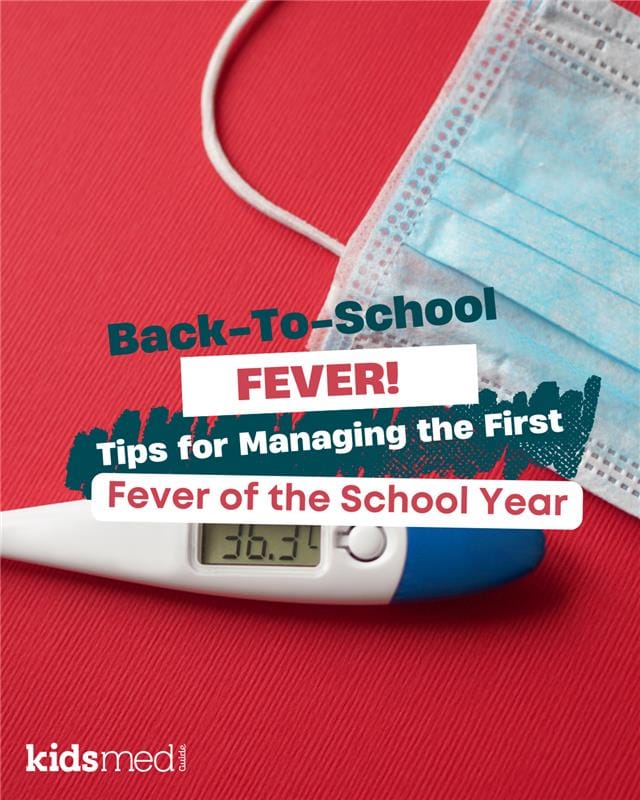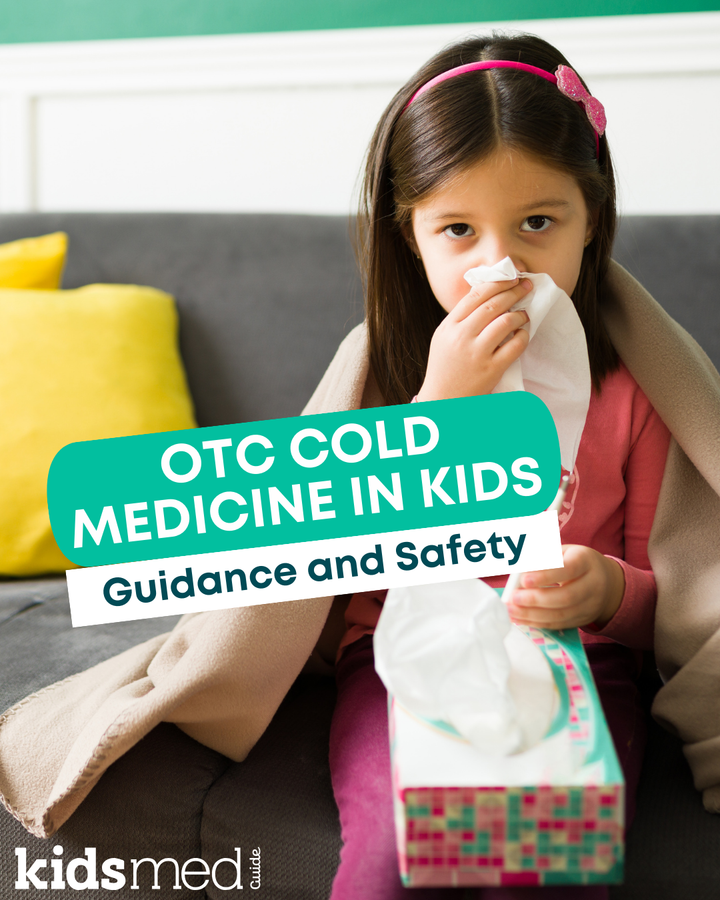Fever Reducers for Kids: Safe Dosing and When to Treat a Fever
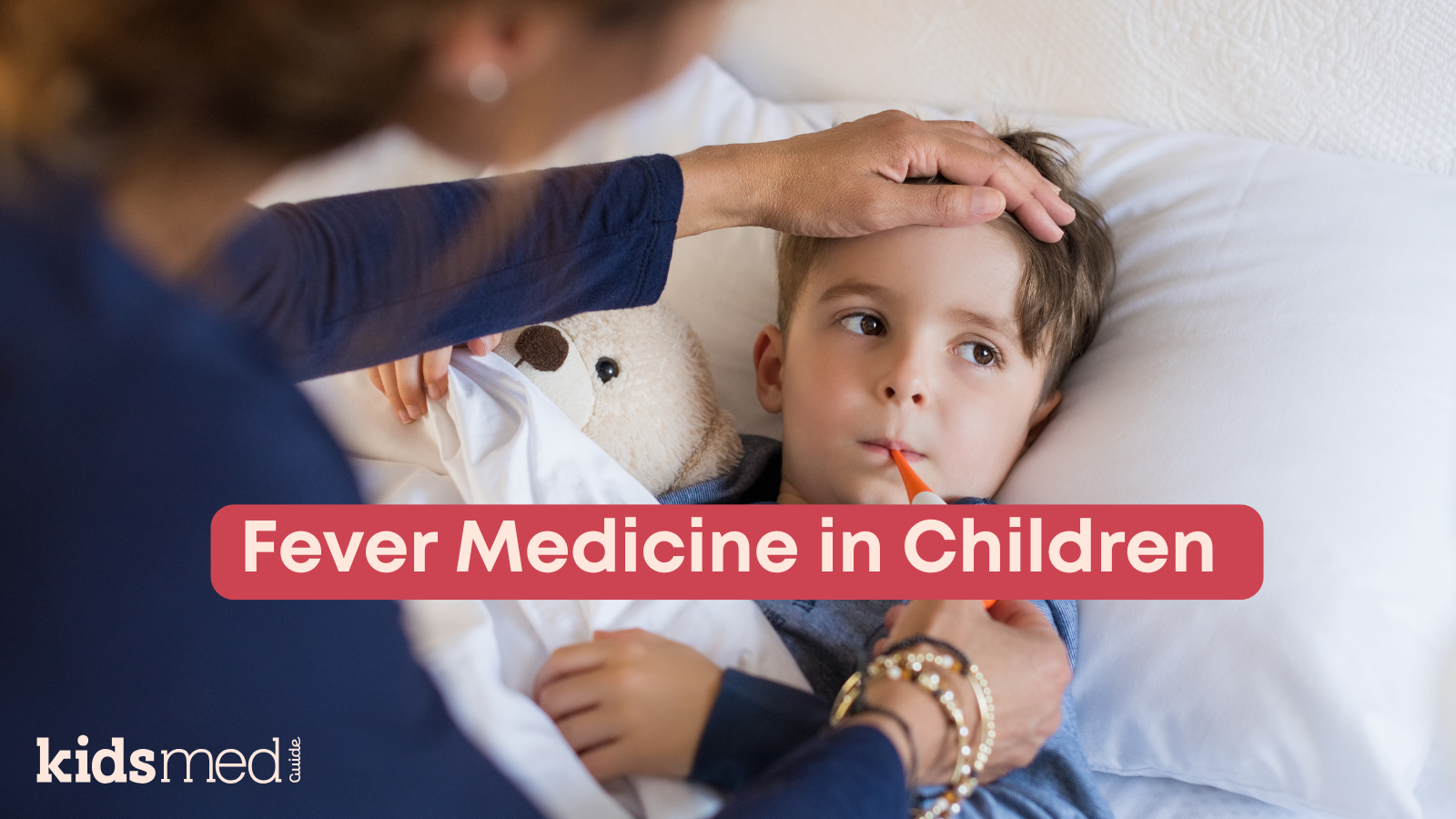
Every kid experiences a fever at some point during childhood. My children, in particular, tend to get them at 3 AM, while on vacation, or during holiday events. There’s also the always fun first fever of the school year. Never a dull moment!
This guide explains fever reducers, when to treat a fever in children, and how to get the correct dosage of fever medication.
Understanding Fever in Children
Fever is a normal immune response, not an emergency on its own. Often, fevers show that your child’s body is fighting an illness. It can be scary when your child has a fever, but as long as they seem okay, it’s usually not a reason to worry!
Most fevers in children are caused by an infection. They can also result from vaccination, heatstroke, or an unknown cause. Fevers due to heatstroke are a medical emergency.
When it comes to a fever, most pediatricians will tell you to treat the child, not the number! If your child is drinking, resting, alert, arousable, breathing normally, and playing in short bursts, you can often skip medication and focus on hydration and rest.
HealthyChildren.org, the American Academy of Pediatrics (AAP) parent site, emphasizes comfort-based treatment over medication use for fever management. Comfort-based supportive care includes giving fluids, wearing light clothing, and getting plenty of rest. The AAP advises against using cold water or rubbing alcohol for sponging.
Medication helps when a fever makes a child so uncomfortable that they can't rest, drink fluids, or are in pain. In these cases, treating the fever will also reduce pain and prevent worse outcomes, like dehydration. When used occasionally as needed and as directed by the product label or your pediatrician, fever reducers are safe for children.
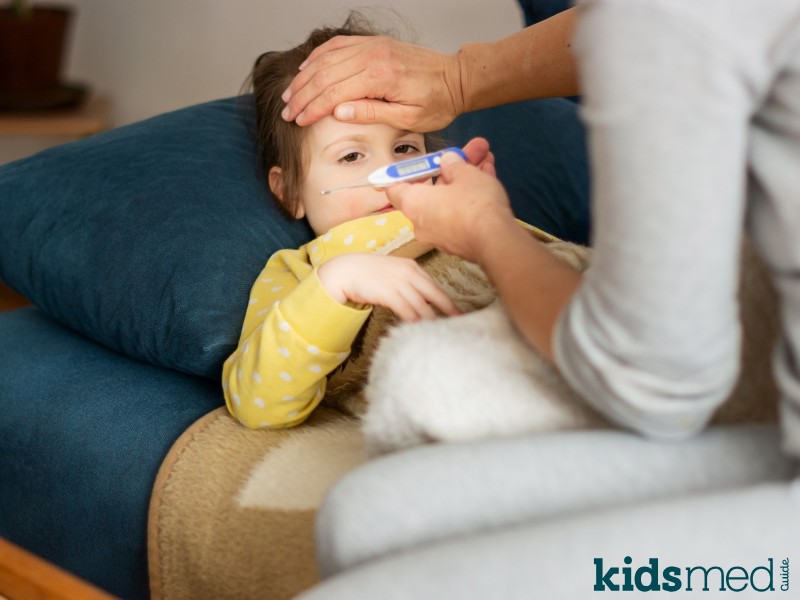
Common Fever Reducers for Children
Acetaminophen (Tylenol®)
Acetaminophen lowers fever and relieves pain. It is available as a liquid, chewables, orally disintegrating tablets, and suppositories if vomiting makes oral medicine difficult.
Typical dosing is 10–15 mg/kg per dose every 4 to 6 hours as needed, with a maximum of 4 or 5 doses in 24 hours (or 75 mg/kg/day). These milligram (mg) per kilogram (kg) dosing calculations can be confusing, but luckily, there is a weight-based dosing chart on the label of children’s acetaminophen products. Speak with your pediatrician or pharmacist if you have dosing questions.
When measuring liquid acetaminophen, always use the oral syringe or dosing cup that comes with the bottle, not a kitchen spoon, to avoid dosing errors.
The AAP and other medical experts advise against using acetaminophen in children under 12 weeks unless your pediatrician recommends it, because a fever this early requires medical assessment. Additionally, consult your doctor before use if your child has a history of liver disease. Do not give acetaminophen to a child who is allergic to it.
Acetaminophen is a common ingredient in many cold and flu relief products. It can be dangerous if you take more than the recommended dose. Therefore, we recommend avoiding combination cough, cold, or flu medicines. If you need to treat a fever with acetaminophen, choose a product that contains only that ingredient.
Ibuprofen (Advil, Motrin)
Ibuprofen lowers fever and also relieves pain and inflammation. Typical dosing is 5–10 mg/kg per dose every 6 to 8 hours as needed. The maximum daily dose is four doses. Calculating milligrams (mg) per kilogram (kg) can be tricky, but children’s ibuprofen products have weight-based dosing charts on their labels. Ask your pharmacist or pediatrician for help with dosing.
When measuring liquid ibuprofen, always use the oral syringe or dosing cup that comes with the bottle, not a kitchen spoon, to avoid dosing errors.
Use special caution with liquid ibuprofen. Two concentrations are available: children’s liquid and infant’s drops. The milliliter (mL) dose instructions differ between these two products.
Staying well-hydrated is important when taking ibuprofen, as dehydration can damage the kidneys and increase the risk of side effects. Take ibuprofen with food if possible, as this helps prevent stomach upset and protects the gastrointestinal tract.
Ibuprofen should not be used if a patient is allergic to it or other drugs in the non-steroidal anti-inflammatory drug (NSAID) class. Consult a doctor before use if your child has a history of kidney disease, bleeding disorders, cardiovascular disease, ulcers, or other gastrointestinal (GI) disorders.
Do not use ibuprofen in patients less than 6 months of age unless specifically recommended to by a pediatrician.
Non-Medication Approaches
Non-medication methods for treating fever are effective and should be tried before or alongside fever-reducing medicines. They can help your child feel more comfortable when fighting a fever and may reduce the amount of medication your child needs!
- Stay hydrated! Anything liquid counts – water, juice, Pedialyte, soup, warm decaffeinated tea, and popsicles are all options.
- Keep the room temperature cool and comfortable. Putting a febrile child in a hot room makes it harder for their bodies to cool down naturally and increases the risk for a dangerous rise in body temperature.
- Dress your child in light clothing. Offer another light layer or light blanket if they have the chills to help them stay comfortable, and remove a layer or light blanket if they are hot or sweating. Be careful to use light layers and avoid overheating. Do not use blankets with infants.
- Encourage quiet activities and plenty of rest. This can be tough with kids! Shoot for an early bedtime, plenty of naps, and let them sleep in if possible. Each family is different, but when my kids are sick, I let them watch TV or use screens. In my house, screen time rules go out the window on sick days!
Do not use alcohol applied to the skin – this advice is dangerous and outdated. Do not use a cold sponge bath.
Do not give aspirin for fever in kids, due to the risk of Reye’s syndrome.
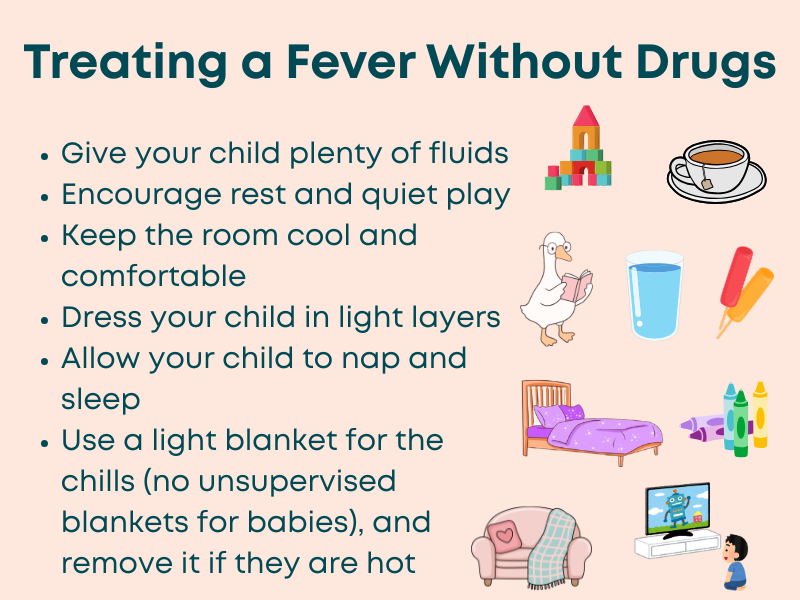
Proper Dosing Guidelines by Age and Weight
Use your child’s weight to determine the correct dose of fever-reducing medication. Dosing by weight is most accurate and ensures your child receives an effective and safe dose. If you do not know the weight, you can use age as a backup, but weight is preferred.
Quick note on liquid strengths:
- Acetaminophen liquid for children: 160 mg per 5 mL
- Ibuprofen children’s suspension: 100 mg per 5 mL
- Ibuprofen concentrated infant drops: 50 mg per 1.25 mL
Infant ibuprofen drops are more concentrated than the children's liquid, so always check the label before using them. We advise only keeping one product – children’s suspension or concentrated infant drops – in your home. This will help prevent mix-ups.
The same goes for chewable tablets and tablets or capsules. Multiple strengths may be available, so use caution and only purchase one strength product.
For children, the dose is based on your child's weight according to the product label. See our guide on understanding OTC product labels!
You may also consult your pediatrician or reference the AAP’s dosing guides:
Safety Precautions and Common Mistakes
- Read the Drug Facts label, including the dosing instructions, every time.
- Use only the measuring device (oral syringe or dosing cup with markings in mL) that came with your product.
- Avoid adult formulations unless your pediatrician instructs you, or if your child is older, of adult weight, and meets the age and weight criteria listed on the product label.
- Keep a written dosing log with time, medicine, and amount. Document each dose given.
- Store meds up and away in child-resistant containers.
- Avoid aspirin in children because of the risk of Reye syndrome.
Alternating or combining acetaminophen and ibuprofen
Ibuprofen and acetaminophen are two different medications that can be used simultaneously. Some studies suggest that alternating or combining acetaminophen and ibuprofen can lower fever more effectively than using only acetaminophen, but this combination therapy is not more effective than using only ibuprofen.
The AAP generally does not endorse alternating or combining therapies because of the risk of mixing up doses, which could lead to an accidental overdose or giving a dose too early. However, some pediatricians recommend alternating or combining therapies to treat stubborn fevers and ease discomfort from serious illnesses like the flu. If your child remains very uncomfortable despite using a single medication, ask your pediatrician about alternating acetaminophen and ibuprofen.
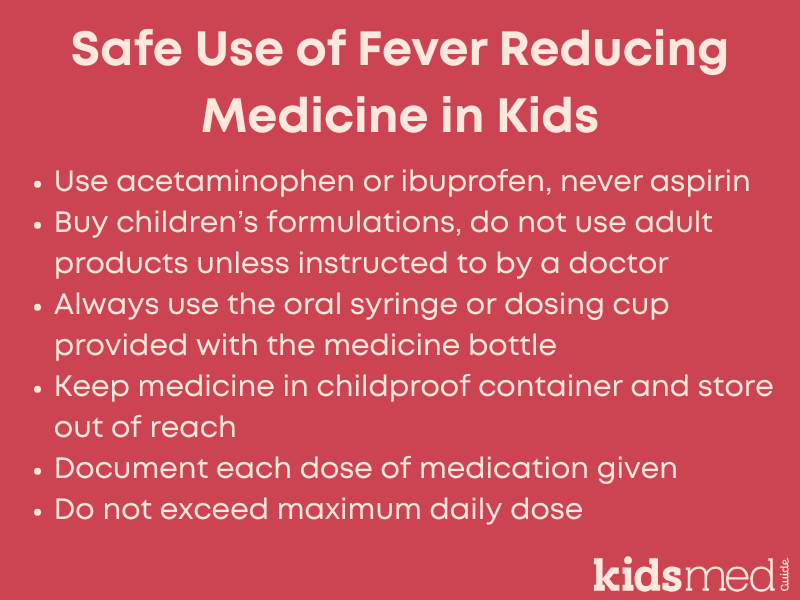
When to Seek Medical Attention
Call your pediatrician or seek urgent/emergent care if your child:
- Is less than 3 months old with a temperature of 100.4°F (38.0°C) or higher.
- Is between 3 and 6 months old with a temperature of 101°F (38.3°C) or higher.
- Is 6-12 months old with a temperature of 103°F (39.4 °C) or higher.
- Has a fever lasting more than 24 hours if under age 2, or more than 3 days if age two or older.
- Has fevers that are consistently above 104, or fevers that go away and then return, especially if accompanied by new symptoms like increased cough or ear pain.
- Has a fever with other symptoms indicating a possible bacterial infection, such as an ear infection, strep throat, urinary tract infection, pneumonia, sinus infection, or meningitis.
- Has a fever and an unexplained rash (i.e., a rash that is not caused by Hand Foot and Mouth, Roseola, or other common childhood illnesses)
- Is dehydrated, lethargic, or having fast or labored breathing, especially if a dose of acetaminophen or ibuprofen doesn’t alleviate these symptoms.
- Is immunocompromised, has a history of cancer, or is taking medications that suppress the immune system, such as steroids.
- Has a central line or other medical port or device that could be at risk of infection.
- Has a febrile seizure.
- Has recurrent, unexplained fevers, or is also experiencing night sweats or other unusual symptoms.
- They were exposed to very hot temperatures, such as those in a hot car, which puts them at risk for heat stroke.
- If your gut is telling you that something is wrong!
This list of scenarios for when to call your pediatrician or seek urgent medical attention serves as a guideline. It doesn’t cover every possible situation. Different doctors might have different advice on when they want to be notified about a fever, and it could depend on a child’s individual health circumstances.
Always follow your doctor’s advice and trust your parental instincts! As a caregiver, you know your child best. If something doesn’t seem right, contact your pediatrician for guidance.
That being said, parents shouldn’t panic. Most fevers aren’t a sign of a problem, and most kids handle the majority of childhood infections just fine.
Educating Caregivers on Fever Management
Share your fever reduction and medication dosing plan with everyone who cares for your child, such as grandparents or daycare providers. Provide a medication and symptom tracker that lists fever reducer drugs, the dose in mL, and timing, with notes for caregivers to record each dose given.
Use the same dosing syringe or cup for every dose, and ensure caregivers know how to follow a drug label to measure the medication in mL on the syringe or cup. Keep medicine in the original childproof containers and store it well out of reach of children, even when on vacation or having a sleepover at Grandma’s house.
Conclusion
Fevers are a sign that the immune system is doing its job! As long as your child is comfortable, able to drink fluids, and getting restful sleep, a fever can be helpful and doesn’t need to be treated with medication.
When your child is uncomfortable, cannot drink fluids, or cannot rest, fever-reducing medicine for children like acetaminophen or ibuprofen can help. Dose by weight according to the drug’s package label, measure doses carefully, and keep a written log of every dose given.
Frequently Asked Questions
What are the safest fever reducers for children?
Acetaminophen and ibuprofen are safe and effective when dosed correctly. Do not give ibuprofen to children under 6 months unless directed by your pediatrician, and consult your pediatrician before giving acetaminophen to babies younger than 12 weeks. A pediatrician should evaluate fevers in infants less than 12 weeks old. Do not give aspirin to children.
How do I determine the proper dose for my child?
Use weight-based dosing and follow the instructions on the product label. Use products intended for children. Acetaminophen is 10–15 mg/kg per dose every 4–6 hours as needed, with a maximum of 4 or 5 doses per day. Ibuprofen is 5–10 mg/kg per dose every 6–8 hours as needed, with a maximum of 4 doses per day.
Can I alternate between acetaminophen and ibuprofen?
Some studies suggest that alternating ibuprofen and acetaminophen might be better at lowering fever than using acetaminophen alone, but it isn't more effective than using ibuprofen alone. The AAP does not officially support switching between the two medications, but some pediatricians recommend it if single-drug therapy doesn’t sufficiently reduce fever. These medications can be used together, though the main risks include accidental overdose, confusing the drugs, or giving doses too close together. Consult your pediatrician if you have questions or want to determine if alternating acetaminophen and ibuprofen is suitable for your child.
What home remedies help reduce fever safely?
Plenty of fluids, light clothing, a comfortable room temperature, and lots of rest. Do not use rubbing alcohol or cold-water sponging.
When should I contact a doctor about my child’s fever?
This can vary based on the child and risk factors, but you should call your child's doctor if they are under 3 months with a fever of 100.4°F or higher, or if the fever lasts more than 24 hours in children under 2, or more than 3 days in kids 2 and older. Additionally, contact your healthcare provider if you notice any concerning symptoms related to how your child looks or acts. For a complete list of guidelines on when to seek medical attention for a fever, see our full article section above titled “When to Seek Medical Attention.”
The following references were used to compile this information:
Acetaminophen Dosing Tables for Fever and Pain in Children. (2021, October 21). HealthyChildren.Org. https://www.healthychildren.org/English/safety-prevention/at-home/medication-safety/Pages/Acetaminophen-for-Fever-and-Pain.aspx
De la Cruz-Mena, J. E., Veroniki, A.-A., Acosta-Reyes, J., Estupiñán-Bohorquez, A., Ibarra, J. A., Pana, M. C., Sierra, J. M., & Florez, I. D. (2024). Short-term Dual Therapy or Mono Therapy With Acetaminophen and Ibuprofen for Fever: A Network Meta-Analysis. Pediatrics, 154(4), e2023065390. https://doi.org/10.1542/peds.2023-065390
Fever Without Fear: Information for Parents. (2025, September 23). HealthyChildren.Org. https://www.healthychildren.org/English/health-issues/conditions/fever/Pages/Fever-Without-Fear.aspx
Ibuprofen Dosing Table for Fever and Pain. (2024, September 19). HealthyChildren.Org. https://www.healthychildren.org/English/safety-prevention/at-home/medication-safety/Pages/Ibuprofen-for-Fever-and-Pain.aspx
Treating Your Child’s Fever. (2022, December 13). HealthyChildren.Org. https://www.healthychildren.org/English/health-issues/conditions/fever/Pages/Medications-Used-to-Treat-Fever.aspx

